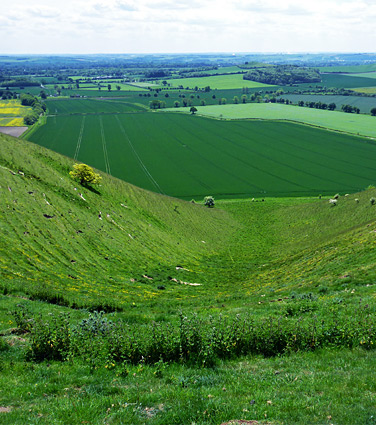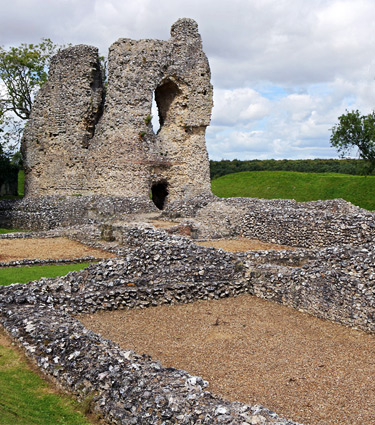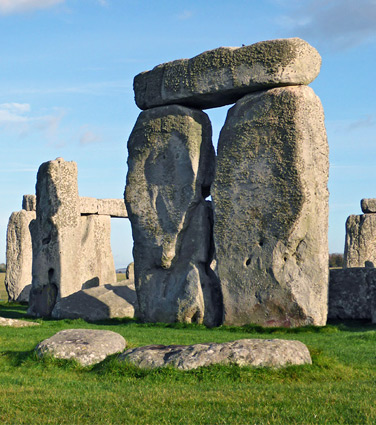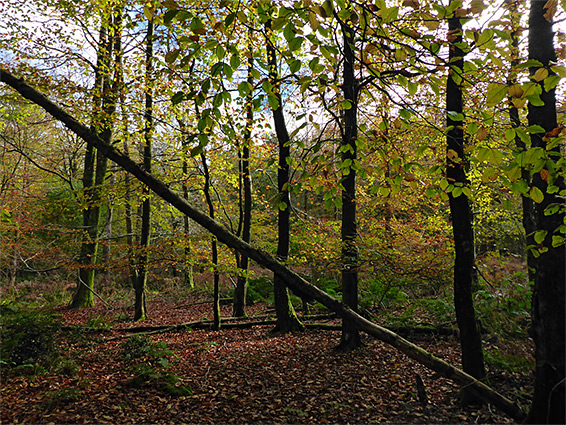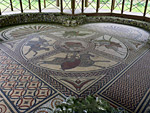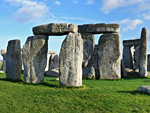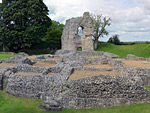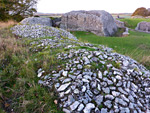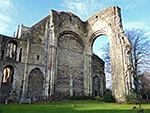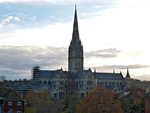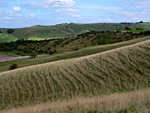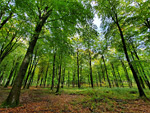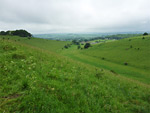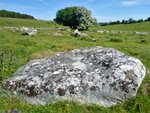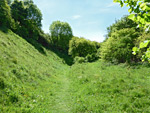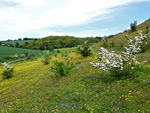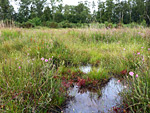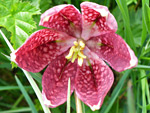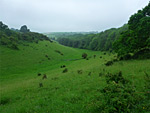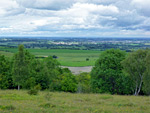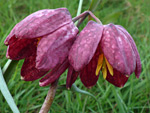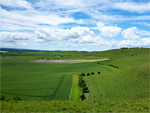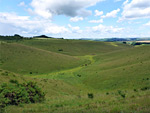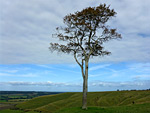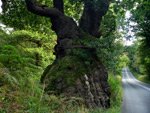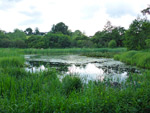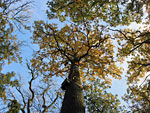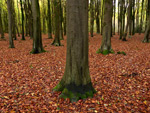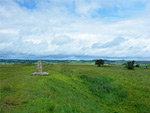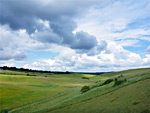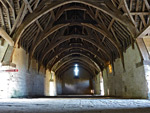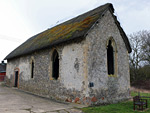Wiltshire extends 50 miles north to south and 35 miles west to east, adjoining Gloucestershire, Berkshire, Hampshire, Dorset and Somerset. All the county has similar landscapes, of fields and woods; generally quite hilly, and split by several wide valleys, but with no particularly high land or overly dramatic natural features.
Contained within are about half of the North Wessex Downs (the remainder is in Berkshire, Oxfordshire and Hampshire), a small part of the New Forest in the south, a narrow section of the Cotswolds in the north, most of Cranborne Chase and nearly all of Salisbury Plain. The latter two are extensive chalk plateaus - this rock underlies well over half of the county, part of a great exposure that stretches eastwards towards Dover, and is responsible for nearly all of Wiltshire's high ground. A number of slopes have been cut to create white chalk figures such as the horses at Chervil, Marlborough and Westbury. The county town of Wiltshire is Trowbridge; other major places include Swindon, Salisbury, Chippenham, Melksham and Devizes.
Wiltshire contains a reasonable variety of ancient places, spanning several millennia, though these are fewer in number than some adjacent counties, and is especially well known for its prehistoric and Neolithic sites. Most famous are Stonehenge and Avebury but there are dozens of lesser locations including burial mounds, ditches, hill forts, standing stones and pathways. The country has one cathedral (Salisbury), three ruined castles (Ludgershall, Old Sarum and Old Wardour), a dozen or more major stately homes - Longleat and Stourhead are the most visited - and a large number of old churches, though no ruined abbeys.
Contained within are about half of the North Wessex Downs (the remainder is in Berkshire, Oxfordshire and Hampshire), a small part of the New Forest in the south, a narrow section of the Cotswolds in the north, most of Cranborne Chase and nearly all of Salisbury Plain. The latter two are extensive chalk plateaus - this rock underlies well over half of the county, part of a great exposure that stretches eastwards towards Dover, and is responsible for nearly all of Wiltshire's high ground. A number of slopes have been cut to create white chalk figures such as the horses at Chervil, Marlborough and Westbury. The county town of Wiltshire is Trowbridge; other major places include Swindon, Salisbury, Chippenham, Melksham and Devizes.
Wiltshire contains a reasonable variety of ancient places, spanning several millennia, though these are fewer in number than some adjacent counties, and is especially well known for its prehistoric and Neolithic sites. Most famous are Stonehenge and Avebury but there are dozens of lesser locations including burial mounds, ditches, hill forts, standing stones and pathways. The country has one cathedral (Salisbury), three ruined castles (Ludgershall, Old Sarum and Old Wardour), a dozen or more major stately homes - Longleat and Stourhead are the most visited - and a large number of old churches, though no ruined abbeys.
Ancient SitesAvebury World Heritage Site Varied collection of ancient monuments including a burial chamber, the highest artificial hill in Europe (Silbury), a stone avenue, and the world's largest stone circle Rating: ★★★★★ |
| Littlecote Roman Villa Foundations of an extravagant Roman settlement, including one of the finest mosaic floors in the country Rating: ★★★★★ |
| Stonehenge A World Heritage Site and Britain's most famous prehistoric monument, on undulating, grassy land of the Salisbury Plain Rating: ★★★★★ |
CastlesLudgershall Castle Tower remains and low wall remnants from a small, 12th century castle frequented by Henry III Rating: ★★★★★ |
| Old Sarum Remains of an Iron Age fort, a Norman castle and an abbey; the original settlement of Salisbury Rating: ★★★★★ |
| Old Wardour Castle Spectacular and substantial ruins of a fortified house, with an unusual, French-style, hexagonal layout; built at the end of the 14th century Rating: ★★★★★; |
Cathedral and ChurchesMalmesbury Abbey Parish church occupying part of an older, much larger building, the remainder of which was destroyed in the 1500s Rating: ★★★★★ |
| St Mary's Church, Wilton Victorian chapel occupying the chancel of a medieval church, adjacent to the ruins of the original nave Rating: ★★★★★ |
| Salisbury Cathedral One of the largest and most beautiful religious buildings of England, with the tallest spire in the country. Most of the cathedral was constructed in the 13th century Rating: ★★★★★ |
Nature Reserves and/or SSSIs, or similarCalstone and Cherhill Downs Chalk grassland at the edge of the North Wessex Downs; hills, slopes and dry valleys, plus several historic sites Rating: ★★★★★ |
| Collingbourne Wood Ancient woodland, mainly beech, formerly coppiced, now only lightly managed, extending 2.5 miles over undulating terrain Rating: ★★★★★ |
| Coombe Bissett Down Narrow, dry valley with steeply-sloping sides, in chalk downland on the south side of the River Ebble Rating: ★★★★★ |
| Dunscombe Bottom Small nature reserve across the west-facing side of a dry, grassy, chalk valley, with a wide selection of spring and summer wildflowers Rating: ★★★★★ |
| Fyfield Down Remote chalk grassland with varied plant life, and numerous sarsen stones. Also the Devil's Den, an ancient burial structure Rating: ★★★★★ |
| Green Lane Woodland Complex A nature park, a wildflower meadow and two sizeable woodland areas, one containing ancient oak trees Rating: ★★★★★ |
| Ham Hill Narrow strip of chalk grassland on a steep, northwest-facing hill above the valley of the River Kennet, with a good range of wildflowers Rating: ★★★★★ |
| High Clear Down Flower-rich chalk grassland, on sloping ground within the North Wessex Downs Rating: ★★★★★ |
| Landford Bog Lowland bog, wet heath and wet woodland, towards the north edge of New Forest National Park; supports a number of rare plant species Rating: ★★★★★ |
| Lower Moor Farm Gateway to four linked nature reserves at the edge of Cotswold Water Park, also including Clattinger Farm, Sandpool and Oaksey Moor Farm Meadow Rating: ★★★★★ |
| Middleton Down Remote, branched, grassy valley in the chalk downland of southwest Wiltshire; a noted wildflower location Rating: ★★★★★ |
| Morgan's Hill Chalk grassland across a north-facing slope, part of the North Wessex Downs, supporting an unusually wide range of wildflowers Rating: ★★★★★ |
| North Meadow Seasonally flooded hay meadow between the rivers Thames and Churn, near Cricklade, containing abundant wildflowers Rating: ★★★★★ |
| Oysters Coppice Deciduous woodland on a gently sloping hillside above the Vale of Wardour, crossed by a few boggy streams Rating: ★★★★★ |
| Parsonage Down Large expanse of grassland and fields across undulating chalk hills, also a working farm. Home to over 150 plant species Rating: ★★★★★ |
| Pewesy Downs Chalk hills, steep slopes and dry valleys; good views and a wide range of wildflowers Rating: ★★★★★ |
| Prescombe Down Branched valley in the chalk downland of Cranborne Chase, with varied wildflowers including the early gentian Rating: ★★★★★ |
| Roundway Down Wildflower-rich chalk grassland on west-facing slopes at the edge of a plateau, centred on an Iron Age hillfort Rating: ★★★★★ |
| Savernake Forest One of the largest wooded areas in southern England, containing hundreds of veteran beech and oak trees, some 1,000 years old Rating: ★★★★★ |
| Smallbrook Meadows Watery habitats beside the rivers Were and Wylye, on chalk soils - wet meadows, wet woods, pools, marsh and ditches Rating: ★★★★★ |
| Vincients Wood Semi-ancient oak, ash and maple woodland at the west edge of Chippenham Rating: ★★★★★ |
| West Woods 12,000 acres of beech and other trees on an ancient woodland site, originally a royal hunting forest. Rating: ★★★★★ |
| White Sheet Hill Chalk downland and ancient monuments at the west edge of the West Wiltshire Downs Rating: ★★★★★ |
| Wylye Down Chalk grassland across both sides of a shallow valley in Cranborne Chase, south of the River Wylye Rating: ★★★★★ |
Other Historic BuildingsBradford-on-Avon Tithe Barn Perfectly preserved 14th century barn with buttressed stone walls and an intricately constructed timber roof Rating: ★★★★★ |
| Chisbury Chapel Small 13th century church, later used as a barn but retaining some original features Rating: ★★★★★ |
Lacock Abbey - 13th century monastery, later convered to a mansion, retaining many original features |
